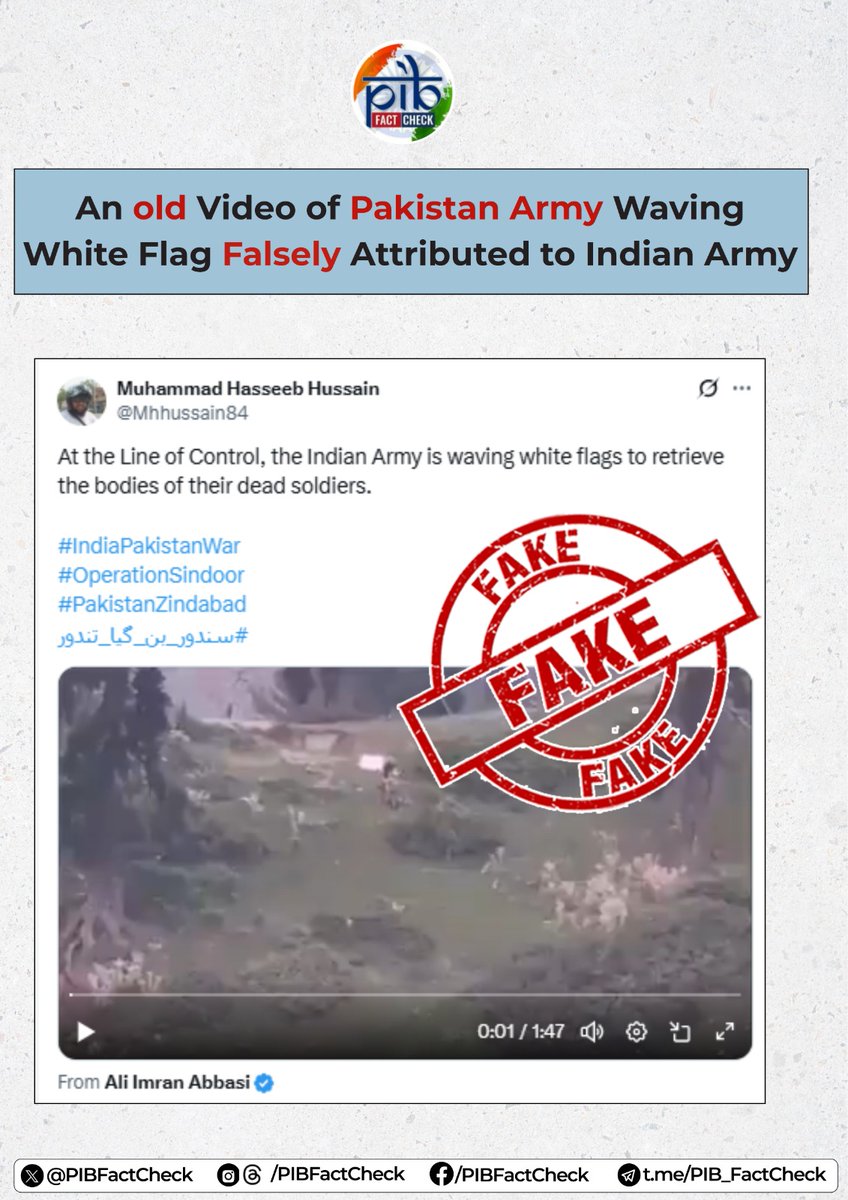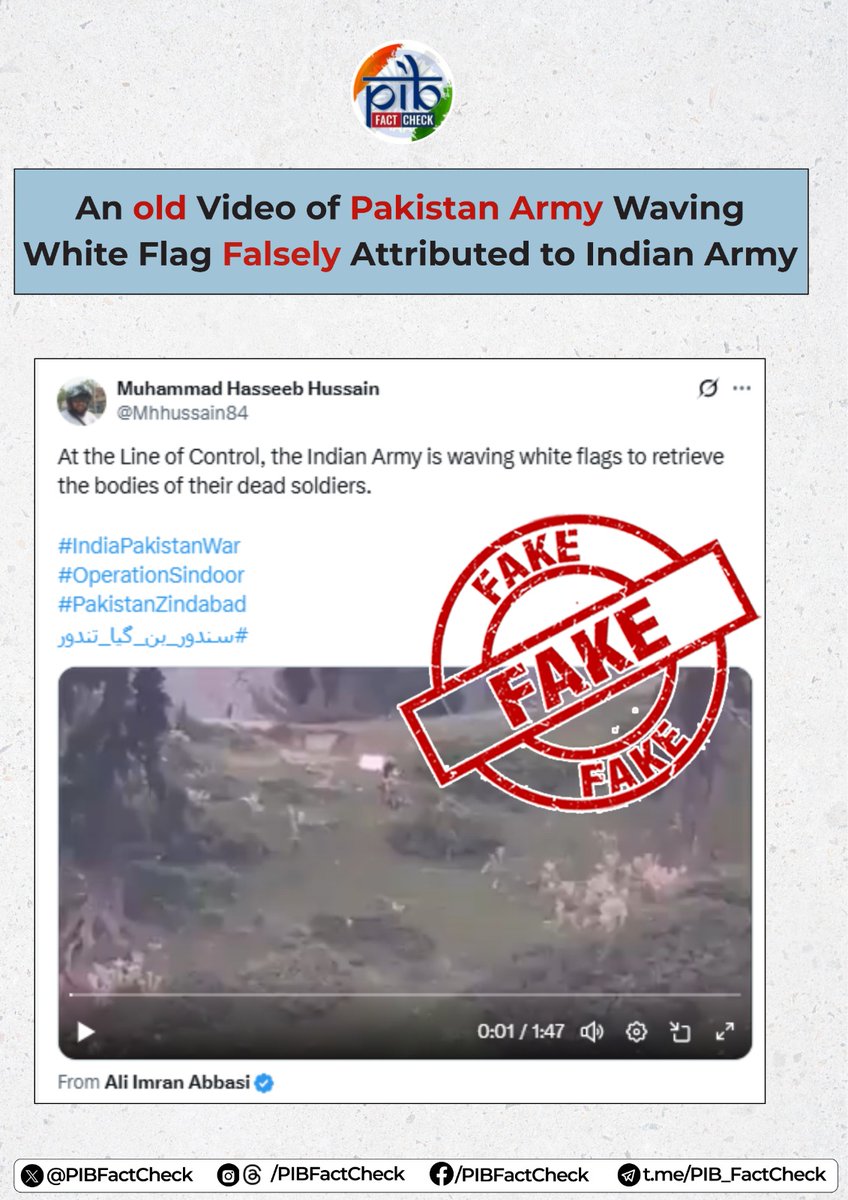Propaganda Alert: Old Video Misused to Ignite India-Pak Tensions!
Propaganda Alert: Misleading Claims and the Importance of Fact-Checking
In today’s digital age, the spread of misinformation has become alarmingly common, especially on social media platforms. A recent incident highlights this issue, involving a deceptive narrative concerning the Pakistan Army and the Indian Army. A video from September 2019 has resurfaced, being misrepresented by various Pakistani accounts, leading to confusion and potential escalation of tensions between the two nations. This incident serves as a critical reminder of the necessity for accurate information and the role of fact-checking in maintaining peace.
Background of the Incident
The controversy began when an old video depicting the Pakistan Army raising a white flag along the Line of Control (LOC) was shared online, with claims suggesting that it showed the Indian Army doing the same. The purpose of raising a white flag typically signifies a request for a ceasefire or an intention to retrieve bodies of fallen soldiers. However, the context of this particular video is crucial as it illustrates an event that occurred over four years ago, not a current or relevant situation involving the Indian Army.
This misinformation was propagated through various social media channels, leading to widespread misunderstandings among the public. The misattribution of the video could potentially incite unnecessary hostility and further strain the already fragile relationship between Pakistan and India.
The Role of Fact-Checking Organizations
In response to the misleading claims circulating online, the Press Information Bureau (PIB) of India took action by issuing a statement through their official fact-checking handle. The PIB Fact Check team promptly identified the inaccuracies in the narrative and provided clarification. They emphasized that the video was old and that it did not depict the Indian Army as claimed. By addressing the misinformation head-on, the PIB aimed to mitigate confusion and prevent the escalation of tensions based on falsehoods.
- YOU MAY ALSO LIKE TO WATCH THIS TRENDING STORY ON YOUTUBE. Waverly Hills Hospital's Horror Story: The Most Haunted Room 502
Fact-checking organizations play a vital role in countering misinformation. Their efforts help to ensure that the public has access to accurate information, which is essential for informed decision-making. In a world where information spreads rapidly, these organizations serve as a crucial line of defense against the harmful effects of propaganda.
The Impact of Misinformation
The dissemination of false information can have far-reaching consequences. In the context of military conflicts, misleading narratives can fuel animosity and provoke reactions that may lead to violence. For countries like Pakistan and India, where historical tensions and conflicts exist, the stakes are even higher. Misinformation can exacerbate existing grievances and lead to a deterioration of diplomatic relations.
Moreover, the spread of propaganda can influence public opinion, creating divisions and fostering distrust among communities. It is imperative for individuals to approach information critically, verifying sources and seeking out reputable fact-checking entities to confirm the validity of claims before accepting them as truth.
How to Combat Misinformation
- Verify Sources: Always check the credibility of the source sharing information. Established news organizations and fact-checking agencies are more likely to provide accurate reports.
- Cross-Reference Information: Look for multiple sources reporting on the same event. If a piece of information is true, it will typically be covered by various reputable outlets.
- Use Fact-Checking Websites: Websites like Snopes, FactCheck.org, and the PIB Fact Check provide tools for verifying claims. These organizations specialize in debunking false narratives and providing accurate information.
- Stay Informed: Keeping up with current events through reliable news sources can help individuals understand the context and background of stories, reducing the likelihood of falling for misinformation.
- Educate Others: Share knowledge about misinformation and the importance of fact-checking with peers and community members. Promoting media literacy can empower others to discern fact from fiction.
Conclusion
The recent case of the misrepresented video involving the Pakistan Army and Indian Army serves as a stark reminder of the ongoing challenges posed by misinformation in the digital age. The rapid spread of false narratives can have serious implications, particularly in the realm of international relations. As consumers of information, it is our responsibility to engage critically with the content we encounter and rely on reputable sources for accurate news.
The efforts of fact-checking organizations like PIB are essential in combating the tide of misinformation. By actively debunking false claims and providing clear, accurate context, these organizations help to maintain a more informed public. In a world where propaganda can quickly influence perceptions and actions, the importance of vigilance and verification cannot be overstated.
Ultimately, fostering a culture of critical thinking and information verification is key to overcoming the challenges posed by misinformation. By equipping ourselves and others with the tools to discern truth from falsehood, we can contribute to a more informed society and promote peace and understanding in our interconnected world.

Propaganda Alert
An old video from September 2019 of the #Pakistan Army raising white flag at LOC to recover bodies of its dead soldiers is being shared by Pakistani handles with the false claim that it is #IndianArmy waving white flags at LOC to retrieve bodies of its… pic.twitter.com/VtC58iqkHr
— PIB Fact Check (@PIBFactCheck) May 7, 2025
Propaganda Alert
In an era where information travels faster than ever, understanding the nuances of what we see and share online is crucial. Recently, a video from September 2019 resurfaced, showing the Pakistan Army raising a white flag at the Line of Control (LOC) to recover the bodies of its soldiers. This footage has been manipulated by various social media handles, falsely claiming it depicts the Indian Army doing the same. This incident highlights the ongoing struggle against misinformation and propaganda in our digital age.
An Insight into the Video
The video in question has been taken out of context, and its original purpose has been obscured. The footage, recorded in a tense environment, was meant to document a critical humanitarian act: the retrieval of fallen soldiers. However, the current narrative being spun by some social media users distorts this fact, using it as a tool to fuel misinformation and hostility. It’s a stark reminder of how visuals can be powerful but also misleading when not accurately represented.
The Nature of Propaganda
Propaganda has existed for centuries, but social media has transformed its reach and impact. Today, anyone with a smartphone can create and disseminate content that can influence public perception. The manipulation of this video is a prime example of how easily misinformation can spread. By framing the narrative in a certain way, these handles aim to sway opinions and create division, all while leveraging the emotional weight of military losses.
Understanding the Context
To grasp the implications of this manipulated footage, we need to understand the historical and geopolitical context surrounding the LOC. The LOC has been a flashpoint for conflict between Pakistan and India for decades. Incidents involving military personnel are sensitive and can provoke strong reactions from both sides. This makes the stakes high for accurate reporting, as misinformation can exacerbate tensions and lead to further conflict.
The Role of Social Media in Modern Warfare
In this digital age, social media platforms have become battlegrounds for information warfare. Propaganda can take many forms, from simple memes to complex disinformation campaigns. The manipulation of the 2019 video is just one instance of how easily narratives can be twisted to serve specific agendas. Individuals and organizations must remain vigilant and critical of the content they consume and share.
Fact-Checking and Misinformation
This incident emphasizes the need for robust fact-checking mechanisms. Organizations like PIB Fact Check play a vital role in verifying information and countering false claims. They provide a crucial service by helping users discern fact from fiction, especially in politically charged situations. When we see a sensational claim, it’s wise to consult reliable sources to confirm its accuracy.
How to Combat Misinformation
So, what can you do to combat misinformation in your daily life? Here are some practical steps:
- Verify Before Sharing: Always check the source of the information. If it seems dubious, do some research before hitting that share button.
- Look for Fact-Checkers: Utilize reputable fact-checking websites to verify claims, especially those involving sensitive topics like military actions or political events.
- Engage in Conversations: Discussing misinformation with friends and family can help spread awareness and encourage critical thinking.
The Impact of Misinformation on Public Perception
When misinformation spreads, it can significantly shape public perception. In the case of the manipulated video, the false narrative created by some Pakistani social media handles can lead to increased animosity between communities. This kind of divisive rhetoric can have real-world consequences, influencing public opinion and, in some cases, policy decisions. It’s essential for consumers of news to approach information critically and be aware of the potential for skewed narratives.
Social Responsibility in Sharing Information
As we navigate the complexities of the information age, we all have a social responsibility to share accurate information. Our actions on social media can contribute to the spread of either truth or falsehood. By choosing to share verified, factual content, we can help foster a more informed public discourse. Remember that every time you hit share, you’re contributing to the larger conversation.
Conclusion
The ongoing battle against misinformation is a challenge we all face. The manipulation of the September 2019 video serves as a reminder of how easily narratives can be twisted and the importance of seeking the truth. By staying informed, verifying claims, and sharing responsibly, we can all play a part in combating the spread of propaganda in our digital world.

